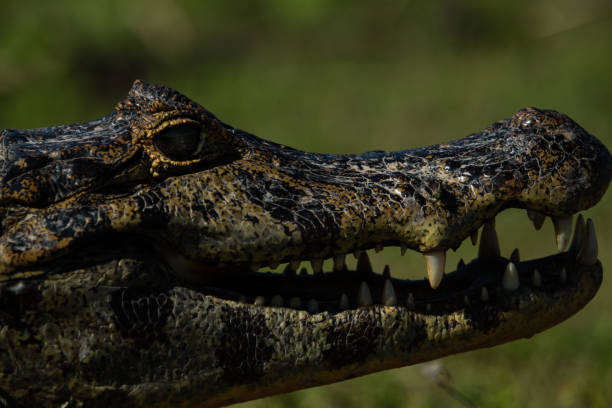ANIMAL: Broad-Snouted Caiman Caiman latirostris Type of Animal: Crocodilian Habitat: Mangroves (freshwater/brackish/salt), marshes (freshwater/brackish/salt), swamps (freshwater/brackish/salt), still/slow-moving waters in tropical forest, manmade cow ponds, lagoons (freshwater/brackish/salt), river drainages, lakes (freshwater/brackish/salt), ponds, water near agricultural areas, rivers (freshwater/brackish), prefers still/slow-moving water Location(s): SE Brazil, NE Argentina, N Uruguay, Paraguay, E Bolivia Appearance: Noted for broad snout, light olive green color, sometimes has spots on face, light underbelly, juveniles brownish olive, yellowish throat on adults Food/Diet: Fish, shrimp, birds, snails, turtles, young crocodilians (including own species), insects, philodendron fruits, amphibians, crabs, crayfish, snakes, lizards Status in Wild: Stable Conservation: Breeding in farms, zoos, wildlife centers, & aquariums. Farmed for meat /skin. Sustainable harvesting done in some areas. Lifestyle: Adults solitary or in groups of 2-15 animals, young live in groups. Additional Info: Called: Male-Bull Female-Cow Young-Hatchling Group-Pod Weight: Male-100 lbs Female-65 lbs Gestation: 2-2.5 months Life Span: 20 years Body Length: Male-8.2 ft Female-6.6 ft Young-2.5 ft Tail Length: Male-3 ft Female-2.5 ft Main predators of adults are jaguars, giant otters, & anacondas. Raptors, ocelots, & snakes prey on young. Small mammals eat eggs. Warmer nest temps create females & colder temps create males. Females lay 18-50 eggs, in two different layers to have a more even sex ratio. Females assist young to water. Skin highly valued due to smooth texture. Sexually mature at 4-6 years old. Breed during rainy season. Males & females bellow during courtship. Like many crocodilians, they’re ambush predators. Due to nose/snout, also called Broad-Nosed Caiman. Threats include water pollution, hunting for skin/meat, & habitat destruction/degradation. Their coloration aids in camouflage. Fluke parasites in cattle have increased in areas where caimans used to be common. One possibility is that decline of caimans results in increase of snails, who are intermediate host for these parasites. Snails important part of caiman’s diet. Fun Fact(s): Females guard nests fiercely, sometimes hissing. The Latirostris in its scientific name is Latin for wide nose. Competes w/ Yacare Caimans sometimes. Like many caimans, they’re highly unpredictable. Individuals in cooler areas & higher altitudes darker than those in lower areas.

